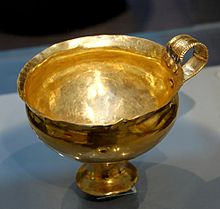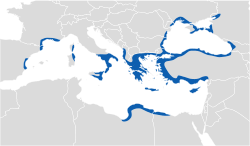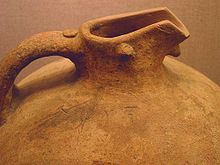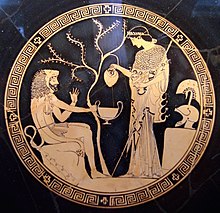History of viticulture in Greece
In the history of Greek viticulture , the great influence of ancient Greece on viticulture in the countries bordering the Mediterranean becomes particularly clear. The Greeks developed new methods of viticulture and cellar technology. They shared the knowledge they had gathered about wine with the peoples with whom they were in contact.
Viticulture in ancient Greece
From archaeological finds of cores in Dikili Tash , a tell near Philippi in the regional district of Drama , researchers gained the knowledge that wild grapevine berries were processed in Greece as early as the late Neolithic period . After a find in what is now Iran, it is the second oldest evidence of its kind in the world. This new finding suggests an expansion of viticulture from Iran across the Bosporus to Greece.
There is already numerous evidence of the widespread use of the vine from the early Bronze Age . Excavations on the island of Crete reveal the pre-Greek history of viticulture in the region. In Vathypetro ( Greek Βαθύπετρο ), an archaeological site near Archanes , one of the oldest wine presses in the world can be seen. The excavated stone press and numerous clay vessels from the Minoan culture prove that Crete was the cradle of Greek viticulture. Due to the close trade links between Crete and Egypt , historians today assume that the Minoans took over viticulture from their neighbors.
The large amphorae found were often storage containers for wine, while smaller vessels were used to store olive oil . The resinated wines that are still produced today are likely to have their origin in the method of preservation used in the past, in which the walls of the amphorae were sealed with resin . The importance of wine in this culture must have already been high, as an ideogram of linear A was identified for the wine.
Thanks to intensive trade relations, wine and viticulture soon came to the island of Santorini , which was then called Thira. Viticulture found its way to mainland Greece via the Cyclades . Presumably, however, this was not the only way of spreading it. Since the Old Babylonians were familiar with viticulture at least as early as the Egyptians, it is likely that it spread across today's Turkish west coast of what was then Asia Minor via the Aegean Islands .

Archaeological evidence of intensive viticulture during the Mycenaean culture between 1600 and 1050 BC Are abundant. In addition to dried seeds and the remains of pressed berries, there are numerous images on ceramic work such as pots and vases. In Pylos , archaeologists found a cellar with 35 well-preserved vessels. On some of these vessels there were inscriptions that indicate their purpose for storing wine. The further developed linear font B already knew ideograms for the terms wine and vineyard, and assumptions suggest that the profession of wine merchant already existed.
Mycenaean ceramics with the export goods olive oil and wine were found in Egypt, Cyprus, Syria, Sicily and southern Italy. On the other hand, Mycenaean Greece imported wine from other regions, as demonstrated by wine mixing vessels from Canaan .
Rituals, festivals and vessels

In Greek mythology , the libation made from liquids such as water, milk, honey, wine or oil was the most common cult act. It happened in the morning and in the evening, for prayer, during the oath, when going on a trip or at symposia and banquets. The vessels used for the libation were mostly different from those for everyday use. A common vessel was Rhyton , libiert was purified by Phiale (φιάλη or phial) and Patera (both bowls) and Lagynos and Guttus (sacrificial cans).
In October, Athens celebrated the Oschophoria grape harvest festival . In winter, the Lenaia followed , which originally asked for growth and fertility in the new year. In February the Anthesteria took place, which has been documented since the 15th century BC. Were celebrated. The anthesteria included drinking wine competitions. The Dionysia were added later.
The berries were mashed in a vessel called Linos . For alcoholic fermentation , the juice obtained was usually placed in a pithos using a goat skin wine tube . Amphorae were used in antiquity as storage and transport vessels for oils and wine, garum , tropical fruits such as dates and others.

Wine was always drunk with water; the consumption of undiluted wine was considered a characteristic of the barbarians . Unmixed wine was used only for the libation at the beginning of a symposium. The usual mixture was five parts water to two parts wine, a mixture of equal parts was already considered immoderate and was called akratos (unmixed). In the beginning, the Greeks often used the wine kettle as a mixing vessel ( Lebes or often incorrectly referred to as Dinos ) as a mixing vessel , but later other forms of crater prevailed. A crater could be quite large, as evidenced by the volute crater of Vix . These large vessels were probably not intended for practical use, but were in a sepulcral context. An insert for the crater, called a psykter , was used for cooling . For this purpose it was filled with fresh water or, less often, with hail or snow.
Pythagoras invented the cup of justice , the construction of which forces the user to drink in moderation. If the cup is filled beyond measure, the entire content will run out. According to legend, this cup was intended for the workers at the water supply on the island of Samos, whose large wine consumption Pythagoras was concerned about.
To fill the transport vessels, ladles or vessel shapes such as the kyathos were used . Jugs, such as Oinochoen or Olpen , were used for transport and pouring . Served as the drinking vessel Skyphos which kantharos and at times very popular drinking cup Kylix . In some regions special forms emerged as drinking vessels, in Laconia, for example, the Lakaina was particularly popular. With their drinking and feasting culture, the Greeks had a great influence on other Mediterranean areas, especially the Etruscans were very much oriented towards the Greek drinking culture.
First mention in literature
The times between 1200 BC BC and approx. 750 BC Chr. Are not so well researched due to the lack of contemporary written sources and are also referred to as dark centuries . It is the time between the end of the so-called Mycenaean palace period and the upswing in the archaic period from around 750 BC. Already in the works of Homer , wine is represented as an important part of everyday culture (→ Pramnian wine ). Both Greeks and Trojans , even the uncivilized shown Cyclops drank wine while the food of the gods from Nectar and Ambrosia was. The only exception was Dionysus , god of wine, joy, grapes, fertility and ecstasy. Even if the mythical Nestor cup mentioned by Homer has not yet been found, several descriptions of Homer are backed up by archaeological finds.
Hesiod was the first Greek author to deal with work in the vineyard and the making of wine in his work. In his epic didactic poem Works and Days , the author, who lives in the 7th century BC, reports on the grape harvest on the island of Chios . By describing the heavenly constellations of Sirius , Orion and Arcturus , the time of harvest can be dated to September. After the harvest, the berries were dried for ten days in the sun and another five days in the shade. Only then did the pressing take place. In addition, Hesiod reports on the correct storage of the wine.
The first botanical observations go back to Theophrastus of Eresos (* around 371 BC in Eresos , Lesbos ; † 287 BC? In Athens ). In his Natural History of Plants , Theophrastus deals - based less on his own studies and more on reports from farmers, travelers, wood cutters and coal burners - above all questions of wood technology and the use of wood, but also the location of various useful plants including the vine. In his work De Odoribus (About the smells) he describes the influence of soils and the water supply on the wine and summarizes the spices that can be added to a wine to improve it.
The fable of the fox and the grapes by Aesop is also associated with viticulture.
Archaic time
In the archaic period (700–500 BC) there was the so-called Great Colonization of the Mediterranean . In addition to overpopulation and securing trade routes, reasons were also internal struggles in Greece. Wine export profited from this colonization to a considerable extent. In addition to Athens as the most important domestic market, markets on the Black Sea , along the Danube as far as what is now Austria, in southern Italy to Solunt and Etruria were opened up. The most important means of transport was the ship, a fact that is also described in Canto 9 of the Iliad. With the founding of Massalia, today's Marseille , the Greeks gave the local Celts their first insights into commercial viticulture and thus laid the foundation for viticulture in France before the Romans .
Early wine legislation
Wine became a popular commodity early on. From Homer we know about the pramnios oinos , a wine from the island of Ikaria . Dionysus, the god of wine, had a legendary encounter with pirates near Ikaria. He is said to have particularly valued the wine of Oinoe (Gr. Οίνος, wine ). The fame later went so far that the pramnios oinos became a synonym for strong, alcoholic wine and did not necessarily have to come from Ikaria. A little later, wines from the Aegean islands were considered excellent. The wines of the island of Chios enjoyed the best reputation, but the products from Lesbos and Thasos were hardly inferior to the former.
The importance of wine since the 5th century at the latest is shown by the example of Thasos, the northernmost Aegean island: a wine law was already known here 2,400 years ago. After the Greeks had shaken off Persian rule, Thasos, like all city-states on the Thracian coast, had to settle in 479 BC. Under the domination of the Athenians and in 478 BC. To join the first Attic-Delian League . The aim of the League of Nations was to expel the Persians from the Greek territories. But as early as 465 BC Thasos revolted against Athens and withdrew from the League. Thucydides suspects that the cause of the Thasitic rebellion was primarily an economic one related to the control of trade and mining.
On two marble slabs that were found on Thasos, there were inscriptions relating to regulations for wine production and wine trade. The older of the two inscriptions could be dated between 480 and 460 BC. Christ can be dated, the younger to the last quarter of the 5th century. In addition to taxation, the trade in grapes , must and wine was also regulated . To control the export, the amphorae were marked with stamps . As a unique selling point, rose petals were added to the ripening wine in order to reinforce the already floral character of the wines from Thasos. This should not only strengthen the marketing of the wine, which was popular up to Athens, but also facilitate the control of the import ban.
In addition to filling the state treasury with wine taxation, the rulers enacted legal regulations for wine production, the disregard of which was punished with heavy penalties. Also in ancient Greece one dealt seriously with the cultivation of grapes. The vine was aligned with the sun and wind and carefully planted in parallel rows. The enormous knowledge of the ancient Greeks also provided development aid to other peoples with regard to viticulture.
Romans and Byzantines
It is believed that viticulture in ancient Greece reached its golden era between the 6th and 4th centuries BC. Had. But also under the Romans and the Byzantines, viticulture in Greece initially retained its high status.
As a result of the battles between the Greek small and medium powers among themselves and with and against Macedonia , the Roman Empire intervened against Philip V of Macedonia . In the Second Macedonian-Roman War (200 to 197 BC) Macedonia was crushed. At the Battle of Pydna in 168 BC BC Macedonia was finally defeated and became a Roman province. The end of Hellenism in 146 BC became geopolitical. Marked by the incorporation of the remaining parts of Greece into the Roman Empire. The city of Athens lost its importance. The main marketplaces accessible to the Greeks were in Rome and later in the south of France. Although Italy had developed its own viticulture, especially in Etruria, without Greek help, the Romans quickly absorbed the knowledge of the Greeks about vine training, location issues and viticulture and spread the assimilated knowledge to almost all Roman provinces. Greek wine was still a sought-after trade item and was traded at high prices. However, the more difficult access to the most important transshipment points had an effect; the reputation of Greek plants faded noticeably. Quality manufacturers who primarily generated their livelihood from exports had to close their production.
With the split of the Roman Empire in AD 395, Greece became part of the Byzantine Empire as part of the Diocese of Macedonia . As Constantinian shift the religious development is designated by the earlier by the Roman Emperor I. Constantine and Licinius issued in 313 Edict of Milan was introduced and in the course of which Christianity was gaining influence in the Roman Empire and finally in the year 380 to the state religion was raised . The associated prohibition of belief in gods in Greece had an impact on wine, at least for a short time, as almost all activities in viticulture were related to Dionysus, the now forbidden god of wine. The shift of power from Rome to Constantinople did not bring about the hoped-for easing of exports either.
Viticulture was almost exclusively restricted to personal consumption or consumption in the monasteries. However, the Greek monasteries did not take on the formative role that the monks played, especially in France and also in Germany (→ viticulture in Germany ). There was therefore hardly any progress to be seen. The wooden barrel for the expansion and storage of wine was not introduced in Greece until the 7th century, almost 400 years after the Western European countries.
Aside from resin, flavoring wines has almost been given up. The dilution of wine was also frowned upon. Nevertheless, the name krasi (a corruption of the expression kratistos oenos ) was retained , which was previously only used for diluted wine; to this day it is synonymous with wine. The expansion of sweet dessert wines based on partially raisined berries became more and more popular.
In 992 the Republic of Venice received a privilege from the Byzantine Emperor Basil II , which significantly reduced the trade taxes in Byzantium and favored the Venetians over the rival cities. The establishment of free navigation through the Adriatic was also trend-setting. The Monemovassios oenos , a wine that was loaded at the port of Monemvasia , became a bestseller . This wine, known under the name Malvasia , was exported to France, Germany and England. The ships needed to export large quantities could no longer call at the small port of the city. The name Monemovassios oenos was therefore quickly expanded to include products from Crete and Santorini.
The privileges enabled the Republic of Venice to import foreign wines at unrivaled low prices. This brought many of the local producers to the brink of ruin. When Byzantium tried to strengthen the predicament of many Greek winemakers in the 14th and 15th centuries, it was too late for most winemakers. The largest export markets of Greece such as Crete were already in the hands of the Italians.
The period between the 15th century and independence
After the conquest of large parts of the Byzantine Empire up to the conquest of Constantinople by the Ottomans in 1453, large parts of the Greek-speaking area belonged to the Ottoman Empire for four hundred years . With the conquest by the Turks in the 15th century, viticulture lost its important role, but was continued to a lesser extent, especially on the islands. An important growing area on the mainland was the coast of Asia Minor around Smyrna . However, the export business came to a standstill in the regions under Turkish rule. Viticulture was rediscovered as an attractive source of income. Taxes were levied not only on wine but also on the production of grapes. However, the level of these taxes was so high that many farmers abandoned their vineyards.
When the Turks withdrew after the Greek Revolution , many agricultural areas were devastated.
On the Ionian Islands ruled by the Venetians , the cultivation of raisins was promoted as an export good, which led to a decline in the cultivation of wine.
From independence to the phylloxera disaster
After the Turks were pushed back in the 19th century, viticulture was reluctantly revived. Queen Amalia motivated farmers to devote themselves more to viticulture and less to tobacco cultivation, which was favored by Turkish landowners. However, during the very stormy and extremely changeable period of the new Greek independence, high-quality viticulture could hardly develop, with the exception of a few wineries the cultivation was mostly anonymous and was done in large quantities for export. This wine was produced using primitive technology and was often sold to France as a blending wine or consumed in the cities. The island's wine, on the other hand, had a good reputation. A contemporary report from 1849 says: island wines are as good as the best Spanish wines and are seduced into the interior of Russia and even to Siberia.
Acquiring high-quality vines was difficult except for the Korinthiaki variety . By the end of the 19th century, the area under vines quadrupled, while the total area under vines only doubled.
In 1898 was in Pylea in Thessaloniki the phylloxera discovered on Greek ground. It spread rapidly across the mainland. Greece knew in 1916 with almost 200,000 hectares of vineyards, the widest spread of viticulture in memory; however, this population was severely restricted by phylloxera within a very short time. The rebuilding of the vineyards was slow because the demand for Greek wine had collapsed between 1925 and the Second World War. In the first two decades of the 20th century, the Sultana grape variety found its way into the Greek vineyards.
Immediately after the Second World War, the Greek Civil War followed , which began in June 1946 and ended on October 9, 1949. The civil war poisoned the political and social climate for several decades and led to a national split into communists and anti-communists.
Greece became a member of NATO on February 18, 1952 . On November 1, 1962, an association agreement with the EEC entered into force. On the morning of April 21, 1967, the military coup in Greece and with it the takeover of power. The Greek military dictatorship ruled modern Greece from 1967 to 1974. Viticulture could hardly benefit from the boom between 1952 and 1967, as the mainly foreign support was concentrated on the construction industry and the Greek merchant fleet.
Viticulture after the end of the military dictatorship
Since the 1950s, wineries have benefited from oenologists trained abroad (above all in France). However, high-quality Greek viticulture only experienced a renaissance with the end of the military dictatorship and the accession of Greece to the European Union : in 1974 a wine law was passed that adapted to European rules. From agricultural subsidies the EU urgently needed were investments made in cellar technology and vineyards. The first big winner of the urbanization of Athens as well as of the emerging tourism was the resinous retsina , which had a long history before 1960, but led a rather shadowy existence .
In the 1960s and 1970s, Stauroula Kourakou-Dragona, today's honorary president of the OIV , campaigned for the introduction of the wine law. The Greek alphabet, which was difficult to understand in the exporting countries, isolated the Greeks from the rest of the wine world. Therefore, the Greeks were allowed to use designations of origin on the bottle label from other languages. French and English terms are mainly used. In the 1970s there were four important wine houses in addition to the wine cooperative: Achaia Clauss , Kambas, Kourtakis and Boutari . Tsantali followed a few years later. Originally conceived for the mass market, their products changed over time into high quality products. A plethora of Greek winemakers trained in the renowned viticulture schools in Bordeaux , Dijon , Montpellier , Geisenheim , Alba , Adelaide (at Roseworthy College) and Davis in California.
literature
- André Dominé (Ed.): Wine . Könemann, Cologne 2000, ISBN 3-8290-2765-6 .
- Gerd Hagenow : From the ancient vineyard. Wine in poetry, customs and everyday life. von Zabern, Mainz 1982, ISBN 3-8053-0589-3 ( Cultural History of the Ancient World 12).
- Rudolf Knoll : Greek Wine . Meininger, Neustadt an der Weinstrasse 1985, ISBN 3-87524-057-X .
- Konstantinos Lazarakis: The Wines of Greece . Mitchell Beazley, London 2005, ISBN 1-84000-897-0 .
- Patrick E. McGovern: Ancient wine. The search for the origins of viniculture . Princeton University Press, Princeton NJ et al. 2003, ISBN 0-691-07080-6 .
- Jancis Robinson (Ed.): The Oxford Wine Lexicon . 3rd completely revised edition. Hallwag, Gräfe and Unzer, Munich 2007, ISBN 978-3-8338-0691-9 .
- Frank Zinn: The wine culture of the Greeks . Books on Demand, Norderstedt 2018, ISBN 978-3-7460-9664-3 .
Individual evidence
- ↑ Ancient Wine Making In Neolithic Greece , in Archeology News Report on March 20, 2007 by Tania Valamoti
- ↑ Wolfgang Schiering : The Greek clay vessels. Shape, purpose and change of form . 2nd Edition. Mann (Gebr.-Mann-Studio-Reihe), Berlin 1983, ISBN 3-7861-1325-4 , p. 148f.
- ↑ Excerpt from the didactic poem Works and Days , verses 570 to 589
- ↑ Excerpt from the didactic poem Works and Days , verses 609 to 617
- ↑ Iliad, Canto 9 , verses 70–72
- ↑ The Chablis, whose name was used worldwide to market dry white wines, met a similar fate in the 20th century.
- ↑ Thucydides I, 100
- ↑ General on Venice's commercial privileges in Byzantium: Julian Chrysostomides: Venetian commercial privileges under the Palaeologi , in: Studi Veneziani 12 (1970) pp. 267–356.
- ^ German Pharmacists Association: Archives of Pharmacy . 1849. p. 169. Available at: Digitized at Google Books
- ^ German Pharmacists Association: Archives of Pharmacy. 1849. p. 169. Available at: Digitized at Google Books
- ↑ Helmut Kalinke, The German Wine and Beverage Market in Numbers , Volume 1, Page 1005.
- ↑ Greece in Google Book by Paul Hellander, Kate Armstrong, Michael Clark and Des Hannigan




